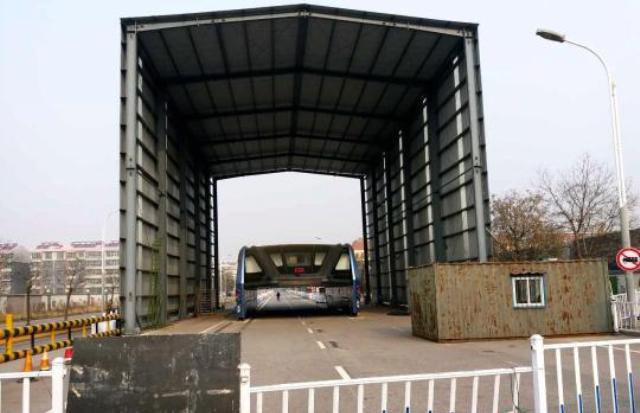After a wave of positive hype in August of this year, China’s Traffic Elevated Bus has been abandoned and seemingly forgotten by its manufacturer in the country’s Hebei province. Produced by Jinchuang Corp., the project—which the Chinese media alleges was a scam—made its first test run over the summer and announced a second one for September, but never took off due to public skepticism and skittish investors. The elevated bus concept garnered interest from around the world due to its seemingly innovative design that promised to change the way cities functioned, straddling traffic and allowing cars to pass under it. After the novelty wore off however, critics began noticing technical issues with the concept such as faulty emergency scenario procedures (passengers would have to exit via a two-story drop in case of an emergency), the fact that vehicles over 6.8 feet could not pass under it (China allows up to 13.7 feet), and the threat of its heavy weight causing a sinkhole. Though the bus is out of service indefinitely, it still continues to block a section of the road it was tested on, irritating local residents of Qinhuangdao. [Shanghaiist+ Popular Mechanics]
The Entropy Table, a 3D-printed prototype by San Francisco-based design consultancy Lunar, was inspired by lattice-structured cubes, modular architecture, and similar 3D-printed structures and objects such as the Arc Bicycle by Delft University of Technology students, in the Netherlands, and the self-printing bridge in Amsterdam—both of which use wire and arch additive manufacturing techniques. [Core 77]
Wind turbines will continue to grow, generate more energy, and become up to 30 percent more cost efficient by 2030, according to online journal Nature Energy. [CityLab]
Pantone’s new color of the year is a grassy spring green called “Greenery,” which is meant to symbolize “the reconnection we seek with nature, one another, and a larger purpose,” says a Pantone Color Institute press release. [Fast Co. Design]
Seattle-based technology-design company Artefact is developing Storyboard VR, a product geared towards designers that will make it easier to produce virtual reality concept templates. [Wired]
The six famous Piccadilly Circus billboards in London are set to be replaced by one continuous, curved LED display that will be in ultra-high definition. [BBC]
ICYMI: Concrete—and moreover its energy-intensive base material cement—may contribute less net greenhouse gas emissions than previously thought due to its ability to act as a carbon sink. [ARCHITECT]
Houston student Alex Le Rouxin Houston has built the first 3D-printed and inhabitable structure in the United States, using his V2 Vesta 3D printer. [3ders.org]
This Curbed article discussed ways in which eastern Tennessee is now booming with 3D printing manufacturers that create everything from modular housing to cars. [Curbed]
Researchers at the University of New South Wales in Sydney say they have increased the efficiency of perovskite solar cells by at least 10 times. [New Atlas]
